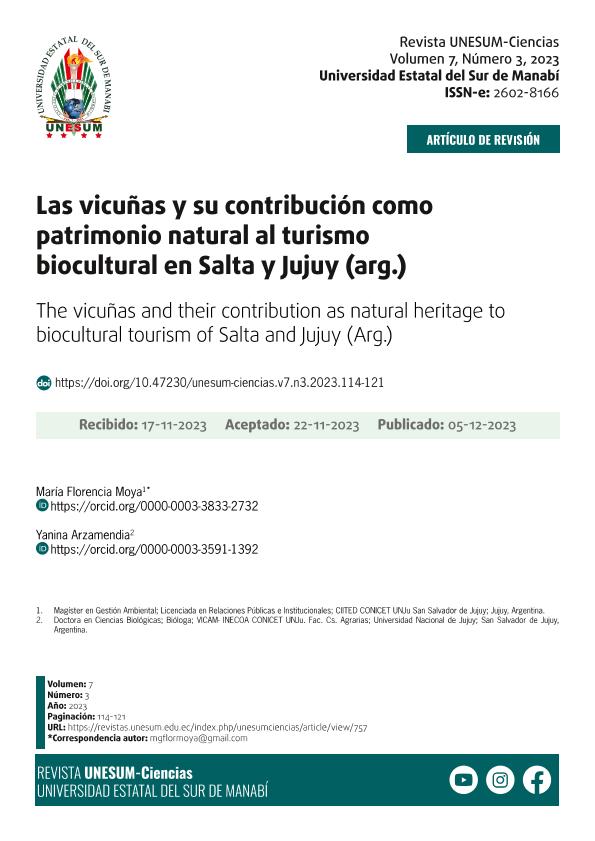Artículo
Con el objetivo de demostrar la importancia que tienen las vicuñas como recurso natural para el desarrollo del turismo biocultural se realizaron entrevistas y registro de campo a fin de obtener información e imágenes de productos turísticos del noroeste argentino. Se parte de indicios que aseveran que las vicuñas, como patrimonio natural, contribuyen al turismo de la región, para lo cual se analizan 60 fotos relacionadas al turismo biocultural en Cafayate y Molinos (Provincia de Salta), y en Purmamarca y Salinas Grandes (Tumbaya, Provincia de Jujuy). Analizando los datos se verifica la diferencia del impacto que tienen las vicuñas en el turismolocal, por lo que se los organiza por similitudes en dos grupos: Cafayate con Purmamarca, y Salinas Grandescon Molinos. En el primer grupo la especie tiene menos representatividad turística en relación al segundo. Registrándose que la historia local del camélido y posibilidad de comercialización de su fibra influyen en lad iferencia. Los resultados adquiridos sirven como base para actuales y futuras investigaciones en la conservación de las vicuñas, de su hábitat, y en el desarrollo de las potencialidades del turismo biocultural. With the objective of demonstrating the importance of vicuñas as a natural resource for the development of biocultural tourism, interviews and field recording were carried out in order to obtain information and images of tourist products in northwest Argentina. It is based on evidence that asserts that vicuñas, as a natural heritage, contribute to tourism in the region, for which 60 photos related to biocultural tourism in Cafayate and Molinos (Province of Salta), and in Purmamarca and Salinas Grandes (Tumbaya, Province of Jujuy). Analyzing the data, the difference in the impact that vicuñas have on local tourism is verified, so they are organized by similarities into two groups: Cafayate with Purmamarca, and Salinas Grandes with Molinos. In the first group, the species has less tourist representation in relation to the second. It is noted that the local history of the camelid and the possibility of commercializing its fiber influence the difference. The results acquired serve as a basis for current and future research in the conservation of vicuñas, their habitat, and in the development of the potential of biocultural tourism.
Las vicuñas y su contribución como patrimonio natural al turismo biocultural en Salta y Jujuy (Arg.)
Título:
The vicuñas and their contribution as natural heritage to biocultural tourism of Salta and Jujuy (Arg.)
Fecha de publicación:
03/2023
Editorial:
Universidad Estatal del Sur de Manabí
Revista:
UNESUM-Ciencias
e-ISSN:
2602-8166
Idioma:
Español
Tipo de recurso:
Artículo publicado
Clasificación temática:
Resumen
Palabras clave:
vicuñas
,
patrimonio natural
,
turismo biocultural
Archivos asociados
Licencia
Identificadores
Colecciones
Articulos(CIITED)
Articulos de CENTRO INTERDISCIPLINARIO DE INVESTIGACIONES EN TECNOLOGIAS Y DESARROLLO SOCIAL PARA EL NOA
Articulos de CENTRO INTERDISCIPLINARIO DE INVESTIGACIONES EN TECNOLOGIAS Y DESARROLLO SOCIAL PARA EL NOA
Articulos(INECOA)
Articulos de INSTITUTO DE ECORREGIONES ANDINAS
Articulos de INSTITUTO DE ECORREGIONES ANDINAS
Citación
Moya, María Florencia; Arzamendia, Yanina; Las vicuñas y su contribución como patrimonio natural al turismo biocultural en Salta y Jujuy (Arg.); Universidad Estatal del Sur de Manabí; UNESUM-Ciencias; 7; 3; 3-2023; 114-121
Compartir




